Analysis of Consumer Decision-Making Approaches in Marketing
VerifiedAdded on 2023/06/01
|6
|1512
|269
Report
AI Summary
This report provides an overview of consumer decision-making approaches in marketing. It examines three primary approaches: extensive problem-solving, limited problem-solving, and routine response behavior. Extensive problem-solving involves high consumer involvement and thorough evaluation, often for expensive or complex products. Limited problem-solving involves a more streamlined approach with less information search, typically for frequently purchased, lower-value items. Routine response behavior, on the other hand, involves minimal involvement and relies on established criteria and habits. The report discusses the characteristics, applications, and examples of each approach, offering insights into how consumers make purchasing decisions and how marketers can tailor strategies to influence these processes.
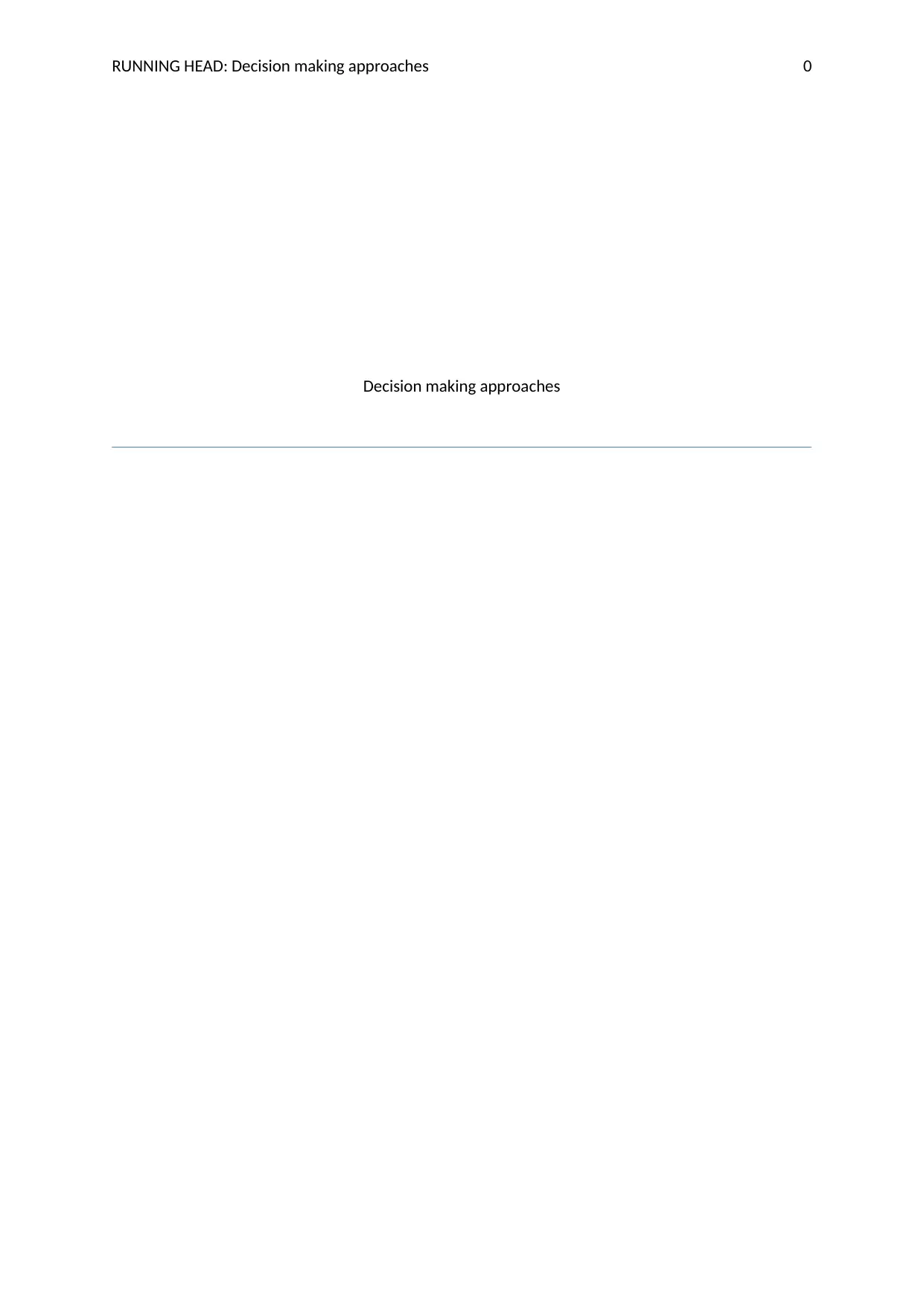
RUNNING HEAD: Decision making approaches 0
Decision making approaches
Decision making approaches
Paraphrase This Document
Need a fresh take? Get an instant paraphrase of this document with our AI Paraphraser
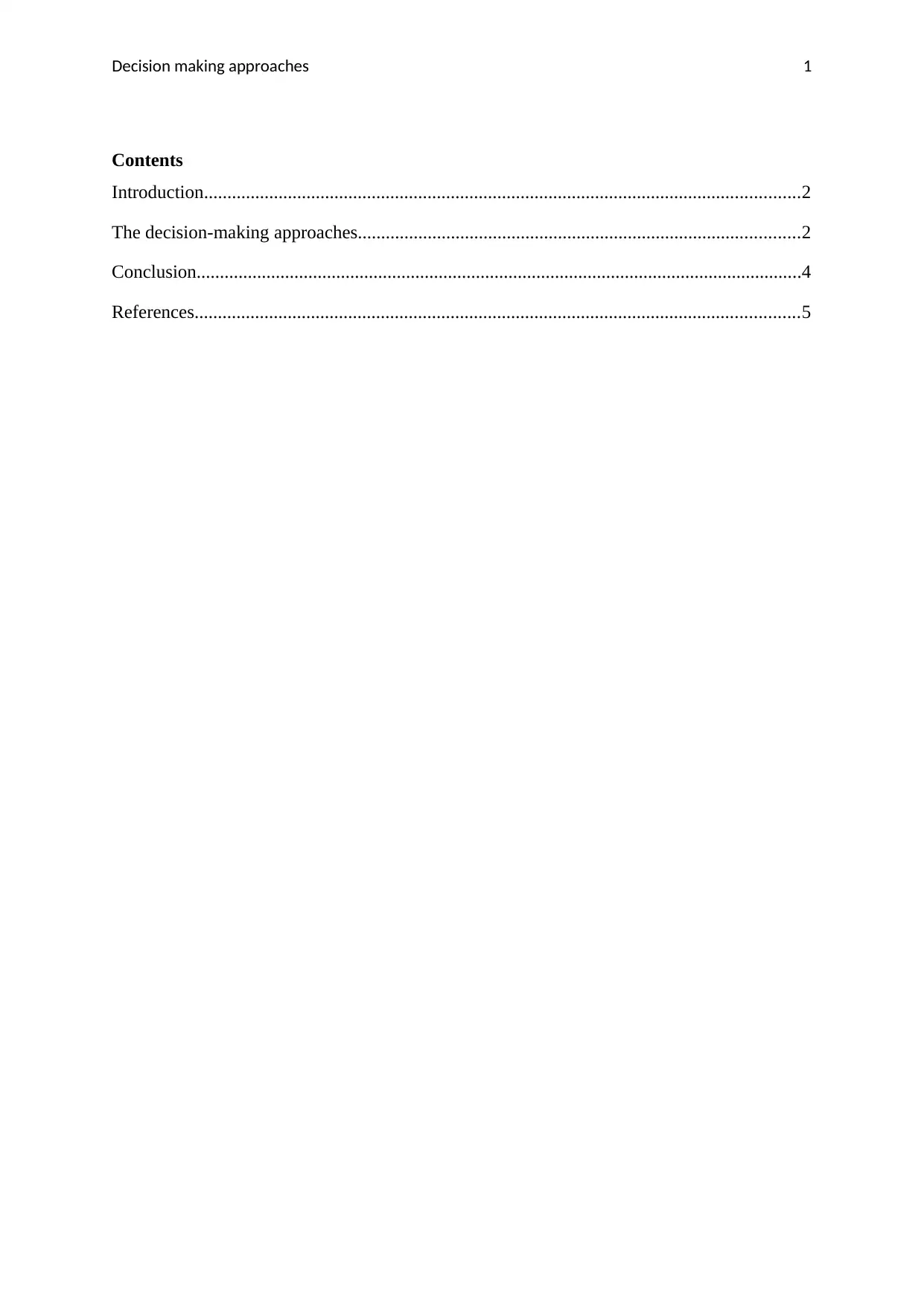
Decision making approaches 1
Contents
Introduction................................................................................................................................2
The decision-making approaches...............................................................................................2
Conclusion..................................................................................................................................4
References..................................................................................................................................5
Contents
Introduction................................................................................................................................2
The decision-making approaches...............................................................................................2
Conclusion..................................................................................................................................4
References..................................................................................................................................5
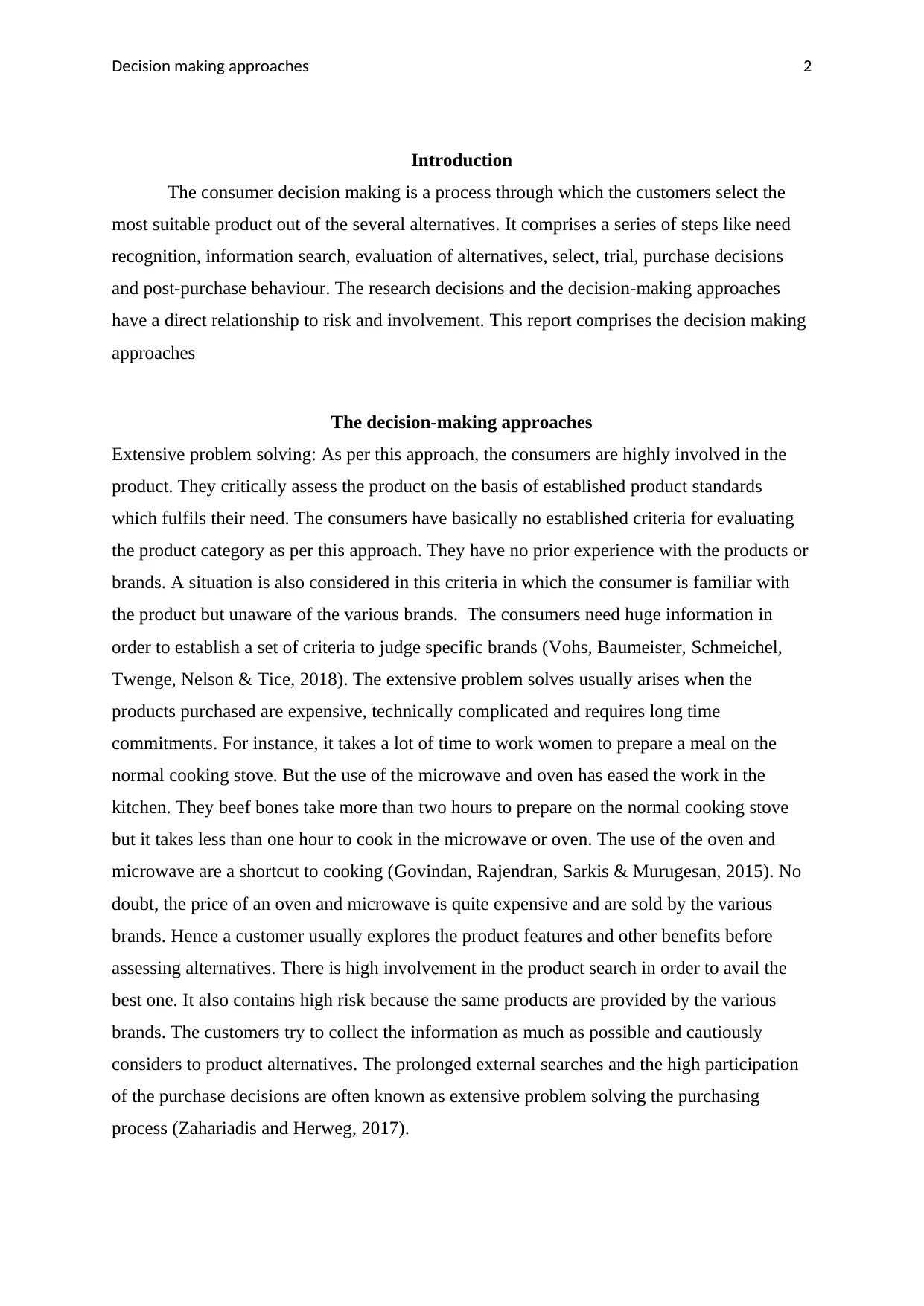
Decision making approaches 2
Introduction
The consumer decision making is a process through which the customers select the
most suitable product out of the several alternatives. It comprises a series of steps like need
recognition, information search, evaluation of alternatives, select, trial, purchase decisions
and post-purchase behaviour. The research decisions and the decision-making approaches
have a direct relationship to risk and involvement. This report comprises the decision making
approaches
The decision-making approaches
Extensive problem solving: As per this approach, the consumers are highly involved in the
product. They critically assess the product on the basis of established product standards
which fulfils their need. The consumers have basically no established criteria for evaluating
the product category as per this approach. They have no prior experience with the products or
brands. A situation is also considered in this criteria in which the consumer is familiar with
the product but unaware of the various brands. The consumers need huge information in
order to establish a set of criteria to judge specific brands (Vohs, Baumeister, Schmeichel,
Twenge, Nelson & Tice, 2018). The extensive problem solves usually arises when the
products purchased are expensive, technically complicated and requires long time
commitments. For instance, it takes a lot of time to work women to prepare a meal on the
normal cooking stove. But the use of the microwave and oven has eased the work in the
kitchen. They beef bones take more than two hours to prepare on the normal cooking stove
but it takes less than one hour to cook in the microwave or oven. The use of the oven and
microwave are a shortcut to cooking (Govindan, Rajendran, Sarkis & Murugesan, 2015). No
doubt, the price of an oven and microwave is quite expensive and are sold by the various
brands. Hence a customer usually explores the product features and other benefits before
assessing alternatives. There is high involvement in the product search in order to avail the
best one. It also contains high risk because the same products are provided by the various
brands. The customers try to collect the information as much as possible and cautiously
considers to product alternatives. The prolonged external searches and the high participation
of the purchase decisions are often known as extensive problem solving the purchasing
process (Zahariadis and Herweg, 2017).
Introduction
The consumer decision making is a process through which the customers select the
most suitable product out of the several alternatives. It comprises a series of steps like need
recognition, information search, evaluation of alternatives, select, trial, purchase decisions
and post-purchase behaviour. The research decisions and the decision-making approaches
have a direct relationship to risk and involvement. This report comprises the decision making
approaches
The decision-making approaches
Extensive problem solving: As per this approach, the consumers are highly involved in the
product. They critically assess the product on the basis of established product standards
which fulfils their need. The consumers have basically no established criteria for evaluating
the product category as per this approach. They have no prior experience with the products or
brands. A situation is also considered in this criteria in which the consumer is familiar with
the product but unaware of the various brands. The consumers need huge information in
order to establish a set of criteria to judge specific brands (Vohs, Baumeister, Schmeichel,
Twenge, Nelson & Tice, 2018). The extensive problem solves usually arises when the
products purchased are expensive, technically complicated and requires long time
commitments. For instance, it takes a lot of time to work women to prepare a meal on the
normal cooking stove. But the use of the microwave and oven has eased the work in the
kitchen. They beef bones take more than two hours to prepare on the normal cooking stove
but it takes less than one hour to cook in the microwave or oven. The use of the oven and
microwave are a shortcut to cooking (Govindan, Rajendran, Sarkis & Murugesan, 2015). No
doubt, the price of an oven and microwave is quite expensive and are sold by the various
brands. Hence a customer usually explores the product features and other benefits before
assessing alternatives. There is high involvement in the product search in order to avail the
best one. It also contains high risk because the same products are provided by the various
brands. The customers try to collect the information as much as possible and cautiously
considers to product alternatives. The prolonged external searches and the high participation
of the purchase decisions are often known as extensive problem solving the purchasing
process (Zahariadis and Herweg, 2017).
⊘ This is a preview!⊘
Do you want full access?
Subscribe today to unlock all pages.

Trusted by 1+ million students worldwide
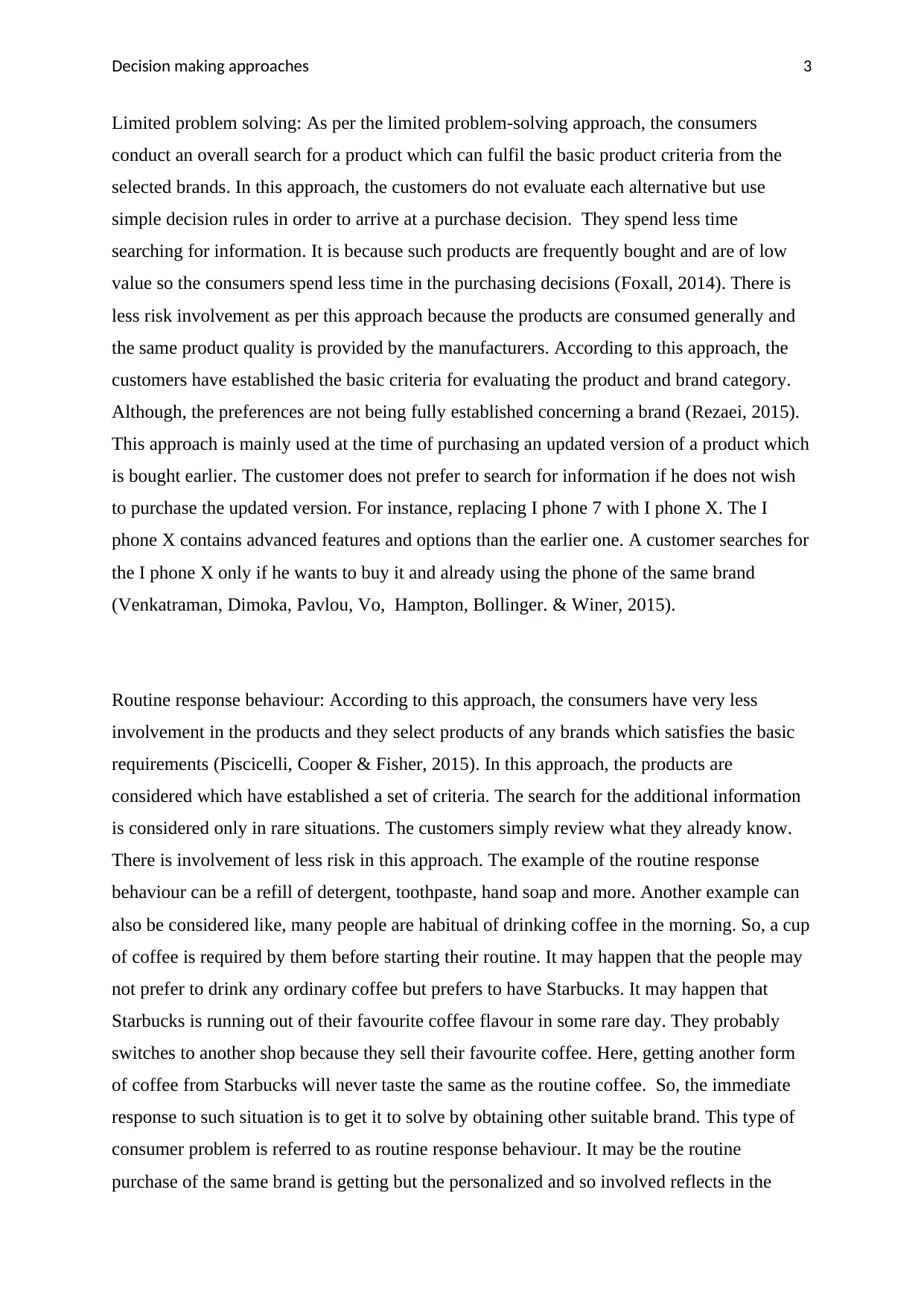
Decision making approaches 3
Limited problem solving: As per the limited problem-solving approach, the consumers
conduct an overall search for a product which can fulfil the basic product criteria from the
selected brands. In this approach, the customers do not evaluate each alternative but use
simple decision rules in order to arrive at a purchase decision. They spend less time
searching for information. It is because such products are frequently bought and are of low
value so the consumers spend less time in the purchasing decisions (Foxall, 2014). There is
less risk involvement as per this approach because the products are consumed generally and
the same product quality is provided by the manufacturers. According to this approach, the
customers have established the basic criteria for evaluating the product and brand category.
Although, the preferences are not being fully established concerning a brand (Rezaei, 2015).
This approach is mainly used at the time of purchasing an updated version of a product which
is bought earlier. The customer does not prefer to search for information if he does not wish
to purchase the updated version. For instance, replacing I phone 7 with I phone X. The I
phone X contains advanced features and options than the earlier one. A customer searches for
the I phone X only if he wants to buy it and already using the phone of the same brand
(Venkatraman, Dimoka, Pavlou, Vo, Hampton, Bollinger. & Winer, 2015).
Routine response behaviour: According to this approach, the consumers have very less
involvement in the products and they select products of any brands which satisfies the basic
requirements (Piscicelli, Cooper & Fisher, 2015). In this approach, the products are
considered which have established a set of criteria. The search for the additional information
is considered only in rare situations. The customers simply review what they already know.
There is involvement of less risk in this approach. The example of the routine response
behaviour can be a refill of detergent, toothpaste, hand soap and more. Another example can
also be considered like, many people are habitual of drinking coffee in the morning. So, a cup
of coffee is required by them before starting their routine. It may happen that the people may
not prefer to drink any ordinary coffee but prefers to have Starbucks. It may happen that
Starbucks is running out of their favourite coffee flavour in some rare day. They probably
switches to another shop because they sell their favourite coffee. Here, getting another form
of coffee from Starbucks will never taste the same as the routine coffee. So, the immediate
response to such situation is to get it to solve by obtaining other suitable brand. This type of
consumer problem is referred to as routine response behaviour. It may be the routine
purchase of the same brand is getting but the personalized and so involved reflects in the
Limited problem solving: As per the limited problem-solving approach, the consumers
conduct an overall search for a product which can fulfil the basic product criteria from the
selected brands. In this approach, the customers do not evaluate each alternative but use
simple decision rules in order to arrive at a purchase decision. They spend less time
searching for information. It is because such products are frequently bought and are of low
value so the consumers spend less time in the purchasing decisions (Foxall, 2014). There is
less risk involvement as per this approach because the products are consumed generally and
the same product quality is provided by the manufacturers. According to this approach, the
customers have established the basic criteria for evaluating the product and brand category.
Although, the preferences are not being fully established concerning a brand (Rezaei, 2015).
This approach is mainly used at the time of purchasing an updated version of a product which
is bought earlier. The customer does not prefer to search for information if he does not wish
to purchase the updated version. For instance, replacing I phone 7 with I phone X. The I
phone X contains advanced features and options than the earlier one. A customer searches for
the I phone X only if he wants to buy it and already using the phone of the same brand
(Venkatraman, Dimoka, Pavlou, Vo, Hampton, Bollinger. & Winer, 2015).
Routine response behaviour: According to this approach, the consumers have very less
involvement in the products and they select products of any brands which satisfies the basic
requirements (Piscicelli, Cooper & Fisher, 2015). In this approach, the products are
considered which have established a set of criteria. The search for the additional information
is considered only in rare situations. The customers simply review what they already know.
There is involvement of less risk in this approach. The example of the routine response
behaviour can be a refill of detergent, toothpaste, hand soap and more. Another example can
also be considered like, many people are habitual of drinking coffee in the morning. So, a cup
of coffee is required by them before starting their routine. It may happen that the people may
not prefer to drink any ordinary coffee but prefers to have Starbucks. It may happen that
Starbucks is running out of their favourite coffee flavour in some rare day. They probably
switches to another shop because they sell their favourite coffee. Here, getting another form
of coffee from Starbucks will never taste the same as the routine coffee. So, the immediate
response to such situation is to get it to solve by obtaining other suitable brand. This type of
consumer problem is referred to as routine response behaviour. It may be the routine
purchase of the same brand is getting but the personalized and so involved reflects in the
Paraphrase This Document
Need a fresh take? Get an instant paraphrase of this document with our AI Paraphraser
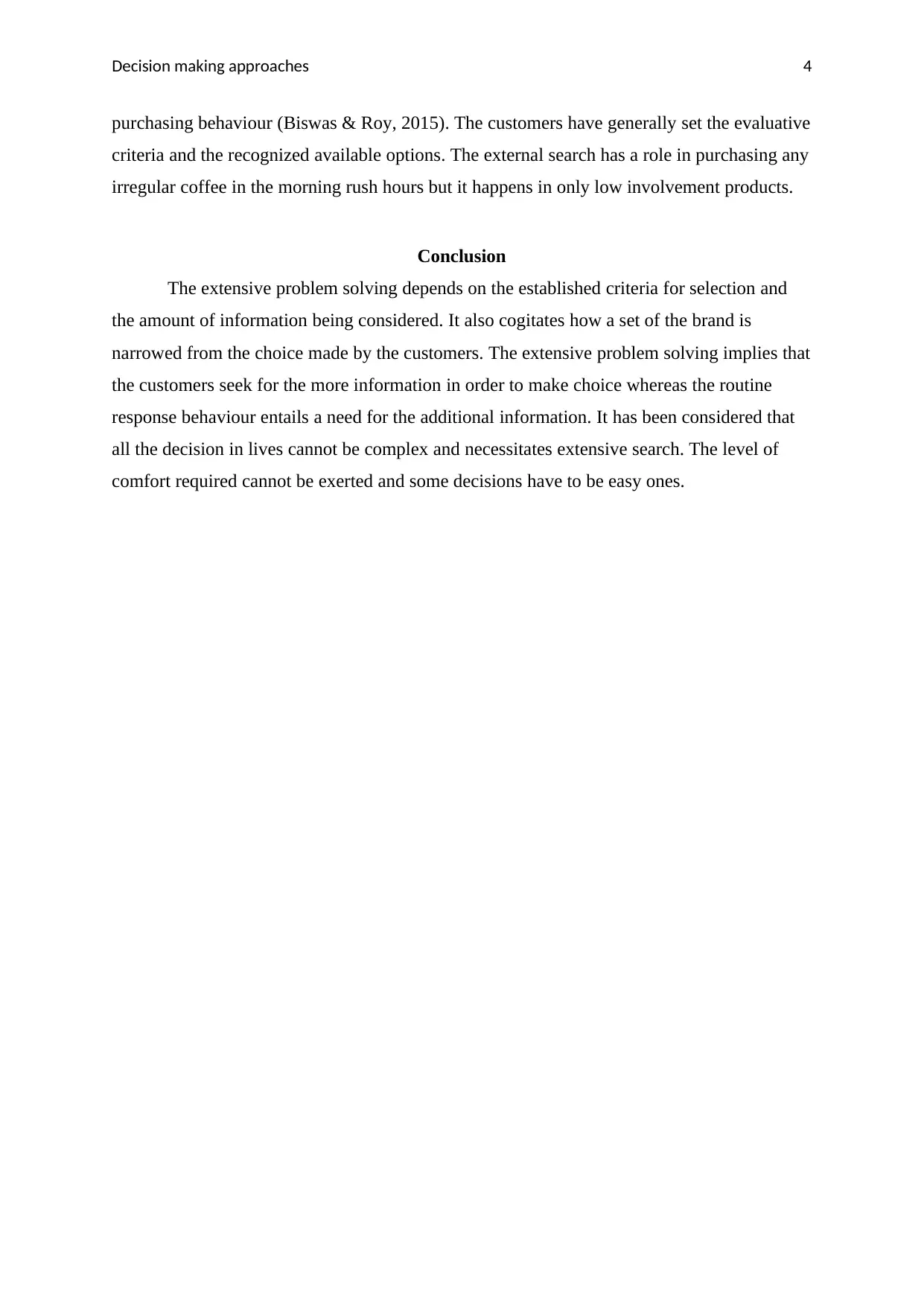
Decision making approaches 4
purchasing behaviour (Biswas & Roy, 2015). The customers have generally set the evaluative
criteria and the recognized available options. The external search has a role in purchasing any
irregular coffee in the morning rush hours but it happens in only low involvement products.
Conclusion
The extensive problem solving depends on the established criteria for selection and
the amount of information being considered. It also cogitates how a set of the brand is
narrowed from the choice made by the customers. The extensive problem solving implies that
the customers seek for the more information in order to make choice whereas the routine
response behaviour entails a need for the additional information. It has been considered that
all the decision in lives cannot be complex and necessitates extensive search. The level of
comfort required cannot be exerted and some decisions have to be easy ones.
purchasing behaviour (Biswas & Roy, 2015). The customers have generally set the evaluative
criteria and the recognized available options. The external search has a role in purchasing any
irregular coffee in the morning rush hours but it happens in only low involvement products.
Conclusion
The extensive problem solving depends on the established criteria for selection and
the amount of information being considered. It also cogitates how a set of the brand is
narrowed from the choice made by the customers. The extensive problem solving implies that
the customers seek for the more information in order to make choice whereas the routine
response behaviour entails a need for the additional information. It has been considered that
all the decision in lives cannot be complex and necessitates extensive search. The level of
comfort required cannot be exerted and some decisions have to be easy ones.
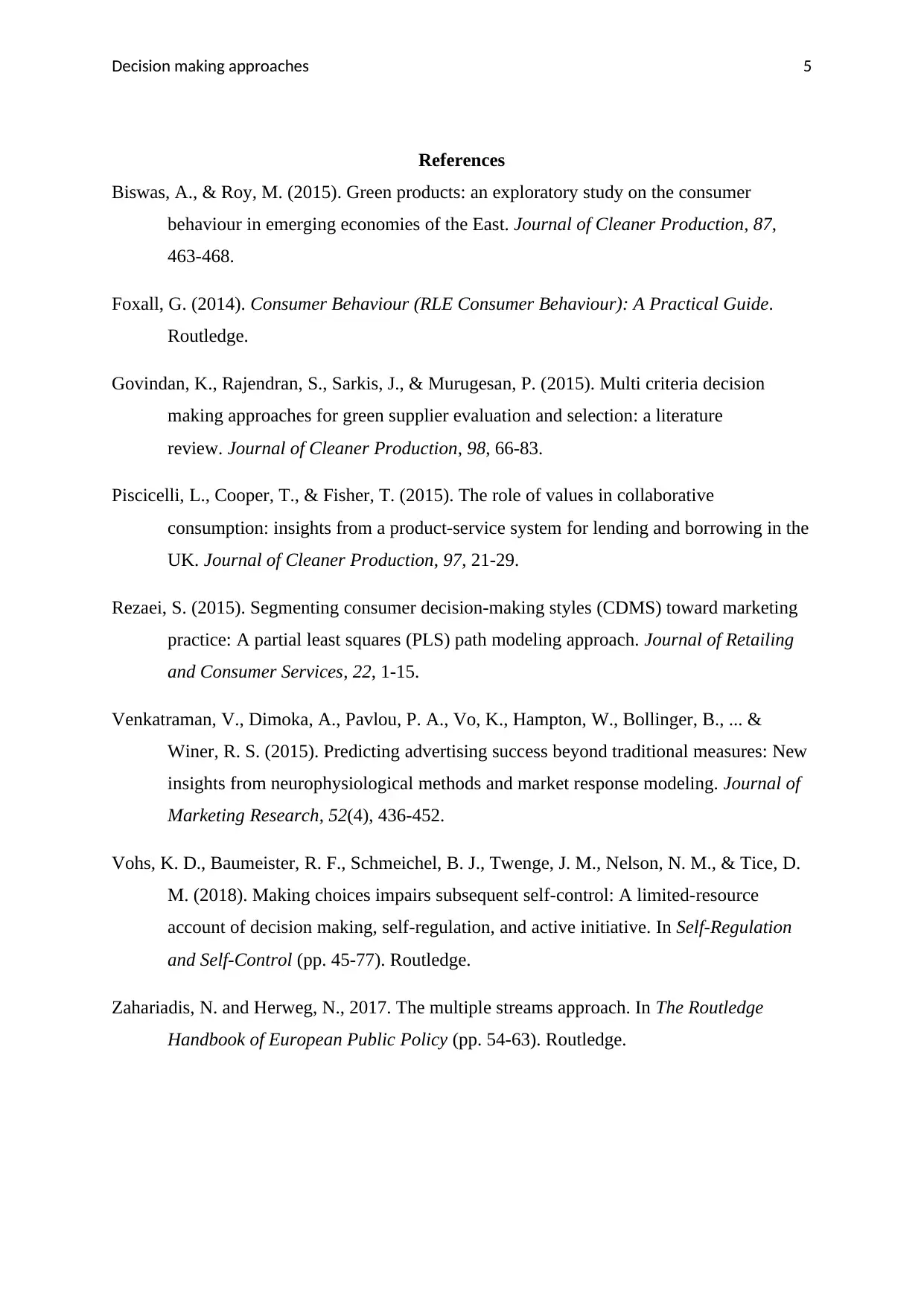
Decision making approaches 5
References
Biswas, A., & Roy, M. (2015). Green products: an exploratory study on the consumer
behaviour in emerging economies of the East. Journal of Cleaner Production, 87,
463-468.
Foxall, G. (2014). Consumer Behaviour (RLE Consumer Behaviour): A Practical Guide.
Routledge.
Govindan, K., Rajendran, S., Sarkis, J., & Murugesan, P. (2015). Multi criteria decision
making approaches for green supplier evaluation and selection: a literature
review. Journal of Cleaner Production, 98, 66-83.
Piscicelli, L., Cooper, T., & Fisher, T. (2015). The role of values in collaborative
consumption: insights from a product-service system for lending and borrowing in the
UK. Journal of Cleaner Production, 97, 21-29.
Rezaei, S. (2015). Segmenting consumer decision-making styles (CDMS) toward marketing
practice: A partial least squares (PLS) path modeling approach. Journal of Retailing
and Consumer Services, 22, 1-15.
Venkatraman, V., Dimoka, A., Pavlou, P. A., Vo, K., Hampton, W., Bollinger, B., ... &
Winer, R. S. (2015). Predicting advertising success beyond traditional measures: New
insights from neurophysiological methods and market response modeling. Journal of
Marketing Research, 52(4), 436-452.
Vohs, K. D., Baumeister, R. F., Schmeichel, B. J., Twenge, J. M., Nelson, N. M., & Tice, D.
M. (2018). Making choices impairs subsequent self-control: A limited-resource
account of decision making, self-regulation, and active initiative. In Self-Regulation
and Self-Control (pp. 45-77). Routledge.
Zahariadis, N. and Herweg, N., 2017. The multiple streams approach. In The Routledge
Handbook of European Public Policy (pp. 54-63). Routledge.
References
Biswas, A., & Roy, M. (2015). Green products: an exploratory study on the consumer
behaviour in emerging economies of the East. Journal of Cleaner Production, 87,
463-468.
Foxall, G. (2014). Consumer Behaviour (RLE Consumer Behaviour): A Practical Guide.
Routledge.
Govindan, K., Rajendran, S., Sarkis, J., & Murugesan, P. (2015). Multi criteria decision
making approaches for green supplier evaluation and selection: a literature
review. Journal of Cleaner Production, 98, 66-83.
Piscicelli, L., Cooper, T., & Fisher, T. (2015). The role of values in collaborative
consumption: insights from a product-service system for lending and borrowing in the
UK. Journal of Cleaner Production, 97, 21-29.
Rezaei, S. (2015). Segmenting consumer decision-making styles (CDMS) toward marketing
practice: A partial least squares (PLS) path modeling approach. Journal of Retailing
and Consumer Services, 22, 1-15.
Venkatraman, V., Dimoka, A., Pavlou, P. A., Vo, K., Hampton, W., Bollinger, B., ... &
Winer, R. S. (2015). Predicting advertising success beyond traditional measures: New
insights from neurophysiological methods and market response modeling. Journal of
Marketing Research, 52(4), 436-452.
Vohs, K. D., Baumeister, R. F., Schmeichel, B. J., Twenge, J. M., Nelson, N. M., & Tice, D.
M. (2018). Making choices impairs subsequent self-control: A limited-resource
account of decision making, self-regulation, and active initiative. In Self-Regulation
and Self-Control (pp. 45-77). Routledge.
Zahariadis, N. and Herweg, N., 2017. The multiple streams approach. In The Routledge
Handbook of European Public Policy (pp. 54-63). Routledge.
⊘ This is a preview!⊘
Do you want full access?
Subscribe today to unlock all pages.

Trusted by 1+ million students worldwide
1 out of 6
Related Documents
Your All-in-One AI-Powered Toolkit for Academic Success.
+13062052269
info@desklib.com
Available 24*7 on WhatsApp / Email
![[object Object]](/_next/static/media/star-bottom.7253800d.svg)
Unlock your academic potential
Copyright © 2020–2025 A2Z Services. All Rights Reserved. Developed and managed by ZUCOL.





